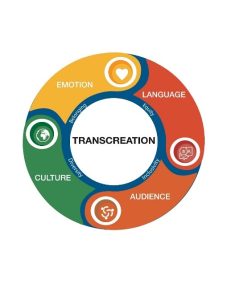Multilingual Transcreation and Translation
Transcreation
Transcreation is adapting a message in the source language so that it resonates with the target audience. The process of transcreating involves a combination of translation and creation. Benefits of transcreation:
- Culturally inclusive practice that best meets the needs of the target audience.
- Sense of belonging
- Higher level of access and relevancy for the target audience.
- Flexibility to address untranslatable terms and phrases.
- Collaboration with internal and external colleagues & teamwork
While translation ensures accuracy and fidelity to the original content, transcreation allows for flexibility and creativity in how we transmit the content so it is comprehensible and connects with the target audience on an emotional level.
When needing to adapt content from one language to another, the team should make a decision on whether to translate or transcreate before beginning the work. There are some scenarios that call for only translation, while others may have more room and flexibility to transcreate.

Examples of translation scenarios:
- Legal documents
- Early Learning Developmental Standards
- External copy written sources (i.e., sources not created or produced by Cultivate Learning)
- Grant or project leader specifically requests translation with the highest level of fidelity
Example of transcreation scenarios:
- The priority is to make content accessible and relevant to the target audience (i.e., “we want the target audience to see themselves in the content and connect with it”).
- Videos and images included in the original source are difficult for the target audience to access and comprehend. There is an opportunity to produce and replace these resources in the target language.
It’s crucial to have this conversation with the entire team to differentiate and explain the processes for translation and transcreation, as many won’t directly request transcreation since it is a new concept and practice.
To learn more about what transcreation means, the process, and see some examples of this in our work, download this interactive Transcreation PowerPoint adapted from Cultivate Learning’s Leading with Heart: From Translation to Transcreation presentation. Check out this overview PDF for a quick peek.
Current Practices
At Cultivate Learning, we have worked to apply transcreation strategies when developing content in languages other than English. Below is a list of transcreation strategies that can be applied to your own content to help make it more relevant, representative, and authentic to your target culture. Finally, don’t feel like you must apply all these strategies. Use the ones that best fit your funders, organization, context and/or audience needs. Note: this list is not final as we continue to evolve this process and add more strategies as we transcreate throughout a variety of projects.
Content Development
- Maintain untranslatable terms in English and explain meaning in target language.
- Create a glossary of terms.
- Find creative ways to write acronyms.
- Research how the terms are being used in the culture, language, or country of origin.
- Exclude English expressions, figurative language, idioms.
- Ask colleagues or people of target language and culture to review content and/or glossary of terms.
- Ensure sentence structure matches target language style and tone.
- Use authentic words in the target language to explain English terms and phrases that do not have a direct translation.
- Include case studies, scenarios, real-world examples that represent the target culture.
- Replace English resources (I.e., reading assignments) with ones that were authentically created in the target language.
Instructional Design
- Participate in the selection of images that are most appropriate for target audiences.
- Collaborate with content developers in the glossary of terms.
- Identify if the delivery of content is best suited in the form of interactives, if so, collaborate with the content developer on which type is best.
- o Example: The content is currently presented as an informational piece, but perhaps it is better as an interactive activity.
- Update the look and feel of the course.
- o Example: The page looks cluttered, so perhaps linking to an external page would be best.
- Identify which menu items need to be translated to be consistent with the course’s language, if not possible, modify the course’s language.
- Example: Several Learning platforms allow for changes in the menu items, so “assignment” can be “asignación”, which correlates with the term throughout the course, however, other Learning platforms do not allow for changes, so it is best to use the default translation “tarea” so that the users can use keyboard shortcuts, like CTL+F.
Multimedia
- Add images or photographs that represent the culture and language of the target audience.
- Think about colors, font type & size the target audience prefers.
- Consider the format that is most accessible to target culture and language: LMS, Rise, Audio Companion, etc.
Delivery
Consider adding the following items to your courses:
- Video lectures in target language.
- Audio lectures in target language (Audio books, podcasts).
- Written lectures in target language (PPTs, Word, PDFs).
- In-person delivery in target language.
- Virtual or online delivery in target language
